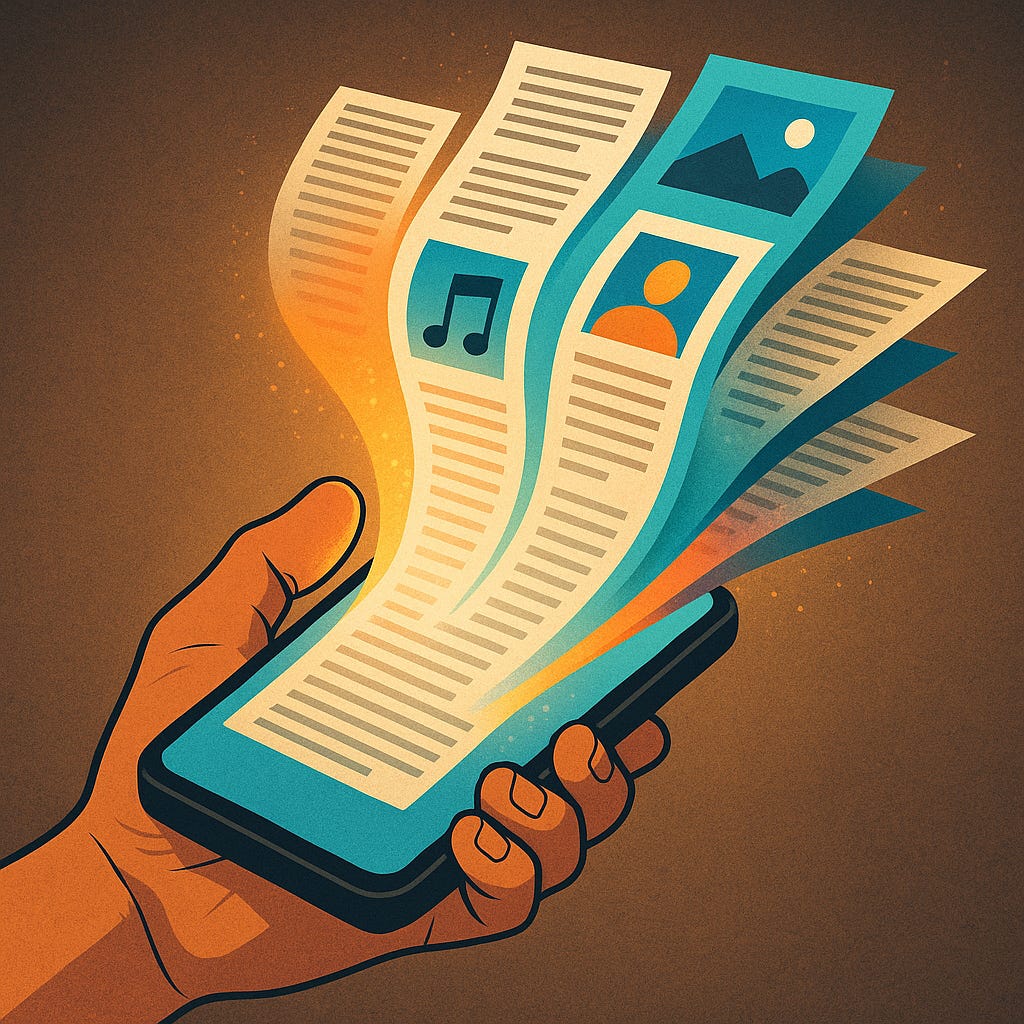Everyone’s a Creator Now
AI and the New Renaissance
You no longer need a studio, a publisher, or a production team.
You need a sentence.
And the tools in your pocket.
Generative systems now write, draw, compose, and film on command. What once required years of skill now takes minutes. We’ve entered a new age of creative abundance. The problem isn’t how to create. The problem is why.
The metaphor for this age is simple: The Printing Press in Your Pocket.
In 1440, Johannes Gutenberg’s invention democratized access to information. It turned Europe from a continent of listeners into a continent of readers.
In 2025, generative AI has done the same for expression. It transforms audiences into authors.
Every text generator, image creator, music composer, and video synthesizer operates as a personal press. Each user holds the capacity to broadcast ideas once confined to studios or institutions.
The scale is staggering. Generative content now makes up an estimated 20–25% of online material, up from less than 2% in 2022.1 The number of daily active users of multimodal creative tools has more than tripled since early 2024.2
The result is not a flood of content—it’s a reordering of culture.
Rewiring
Generative systems lower the threshold between thought and output. That shift rewires three fundamentals of creativity:
1. Time Compression
An idea once trapped in a notebook can become a draft, a storyboard, or a prototype within minutes. The distance between ideation and publication is collapsing.
2. Skill Translation
Tools now serve as skill translators. They turn intent into artifact. The barrier to entry for creative work moves from technical mastery to conceptual clarity.
3. Cognitive Redistribution
AI takes over repetitive creative labor—editing, formatting, captioning—while humans retain direction. Attention, not ability, becomes the scarce resource.
Yet this new ease introduces tension. Many creators report “tool fatigue.” Constant iteration can erode authenticity. The creative act risks feeling mechanical. The question shifts from Can I produce? to Should I?
The system’s power lies in its neutrality. AI will produce anything it’s asked to. The user becomes both author and editor-in-chief, deciding what deserves to exist.
Example
Consider a pastor-entrepreneur preparing a daily leadership tip.
In less than an hour, they outline an idea, generate a script, synthesize a background track, and publish a short video. What once took a day of planning and post-production now fits between morning coffee and a staff meeting.
This workflow illustrates the new Renaissance principle: creation as iteration. Instead of perfection, the goal becomes momentum. The act of expression fuels refinement.
Yet the same accessibility that empowers also overwhelms. The creator faces infinite possibility. Without intent, abundance becomes noise.
SEMIOTIC TURN
The sign of this moment is the blurred line between creation and curation.
A century ago, mechanical reproduction separated the artist from the audience. Today, synthetic generation merges them.
Meaning now depends less on originality and more on coherence. The symbol of authorship—your name, your narrative voice, your ethics—anchors credibility in a sea of synthetic fluency.
In semiotic terms, the “sign” of creativity has inverted. Once, the creator was defined by craft. Now, the creator is defined by choice.
The modern creative signal is discernment.
PLAYBOOK
1. Start with intent.
Define the single message you want to communicate. Write it in one line before opening any tool.
2. Generate broadly.
Use a text generator, visual tool, or audio synthesizer to create multiple drafts or variations. Quantity first, quality second.
3. Refine with constraint.
Select one draft that aligns with your message. Remove what doesn’t serve the idea. Tools make volume easy; clarity still requires editing.
4. Humanize the frame.
Add context, tone, and ethical framing in your own words. Readers don’t connect to precision—they connect to presence.
5. Publish, review, repeat.
Post publicly. Review engagement and feedback. Adjust your next iteration. Creation becomes a cycle, not an event.
BENEDICTION
The Renaissance didn’t end with Gutenberg’s press. It began there.
Our moment mirrors his. The tools have changed; the calling hasn’t.
What you express now shapes what the world believes next.
Stanford Institute for Human-Centered Artificial Intelligence, AI Index Report 2025, April 2025.
Menlo Ventures, Generative AI Consumer Usage Report Q2 2025, June 2025.


